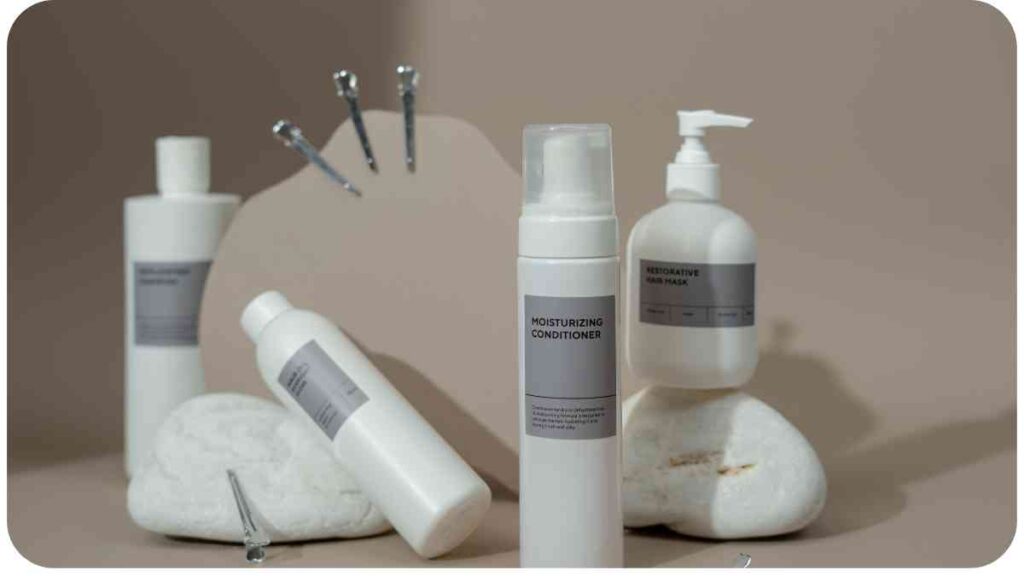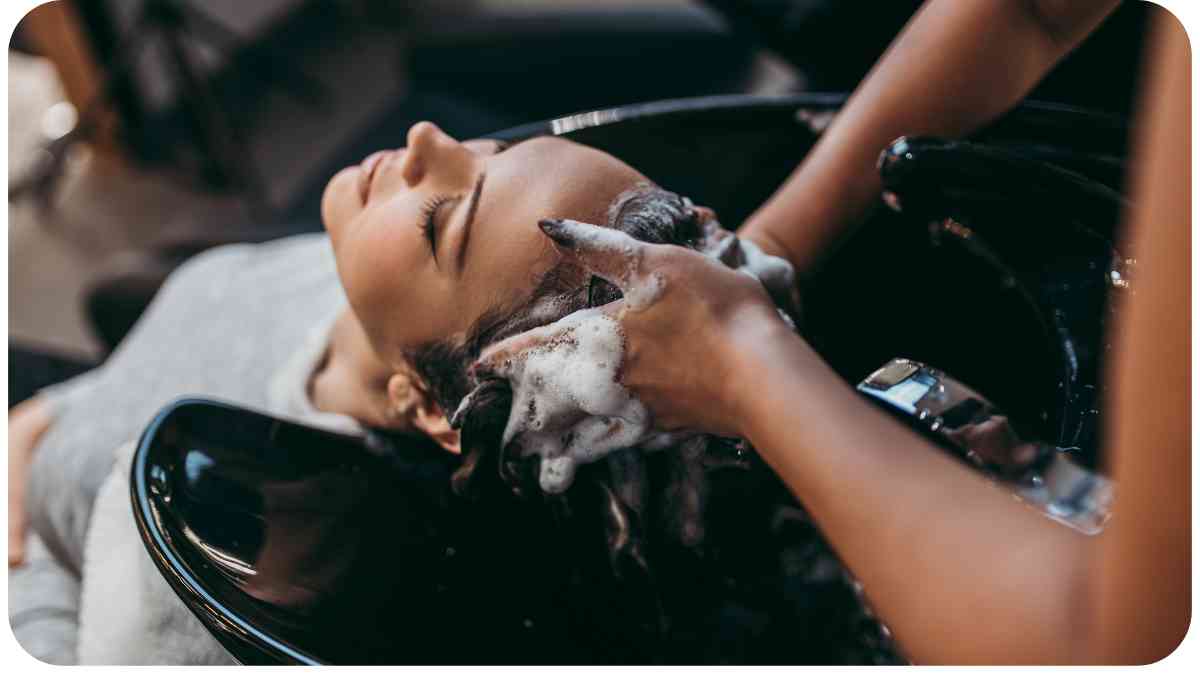Hair porosity refers to your hair’s ability to absorb and retain moisture. Understanding your hair’s porosity level is crucial for proper hair care and choosing the right products. It determines how well your hair absorbs and holds onto moisture, affects how products interact with your hair, and plays a role in overall hair health.
Properly managing hair porosity can help you maintain healthy, hydrated, and lustrous hair. In this comprehensive guide, we will delve deep into the concept of hair porosity, how to determine your hair’s porosity level, and how to develop a hair care routine tailored to your specific porosity needs.
| Takeaways |
| Understanding hair porosity is crucial for maintaining healthy and hydrated hair. |
| Low porosity hair requires lightweight, water-based moisturizers and heat or steam treatments for better moisture absorption. |
| High porosity hair benefits from regular deep conditioning, protein treatments, and the use of products that seal in moisture. |
| Normal porosity hair requires a balanced approach with moisturizing shampoo, regular conditioning, and appropriate hydration techniques. |
| Adapting your hair care routine based on the seasons and specific porosity needs can help address seasonal challenges. |
| Minimizing heat styling and taking precautions with coloring treatments can reduce the impact on hair porosity. |
| Experimentation and consistency are key when finding the best routine for your hair’s specific porosity level. |
The Importance of Hair Porosity in Hair Care
Hair porosity plays a significant role in how your hair responds to different styling techniques, treatments, and products. Understanding your hair’s porosity level allows you to make informed decisions about the nutrients and moisture your hair needs.
Determining your hair porosity enables you to choose the right products, create a suitable hair care routine, and troubleshoot any issues. Whether you have low porosity, high porosity, or normal porosity hair, tailoring your hair care practices to your hair’s needs will lead to healthier, more manageable hair.
To assist you in understanding hair porosity and how it impacts your hair, the following sections will explore the characteristics and care routines specific to each porosity type: low, high, and normal.
Caring for curly hair can be a challenge, but with the right techniques and products, it becomes a breeze. Learn more in our comprehensive guide on curly hair care.
How to Determine Your Hair Porosity

Determining your hair porosity level is an essential step towards understanding how your hair interacts with moisture. Here are a few tests you can perform to identify your hair porosity:
- The Water Test: Take a strand of clean hair and place it in a glass of water. Observe how your hair behaves. If it sinks quickly, you likely have high porosity hair. If it stays afloat for a while, you may have low porosity hair. If it sinks slowly to the middle of the glass, it suggests normal porosity hair.
- The Slip ‘n’ Slide Test: Take a strand of hair and gently run your fingers up the shaft from the ends to the roots. If your fingers move smoothly, your hair likely has low porosity. If your fingers catch or feel rough, you may have high porosity hair.
- The Spray Bottle Test: Spritz a small section of your hair with water. Observe how the water interacts with your hair. If the water beads up and takes a while to be absorbed, you likely have low porosity hair. If the water is quickly absorbed and your hair feels damp, you may have high porosity hair.
Remember that hair porosity can vary throughout your hair, so it’s important to test multiple sections to get a comprehensive understanding of your hair’s porosity level.
Understanding Low Porosity Hair
Characteristics of Low Porosity Hair
Low porosity hair has a tightly bound cuticle layer, which makes it more resistant to moisture absorption. The cuticles lay flat and can be challenging for moisture to penetrate, resulting in your hair taking longer to dry. Some common characteristics of low porosity hair include:
- It repels water and is slow to absorb moisture.
- Products tend to sit on the hair instead of absorbing.
- Hair may feel coated or weigh down easily.
- It is prone to product build-up and can become greasy quickly.
- It can be resistant to chemical treatments such as hair dyes or perms.
Best Products for Low Porosity Hair
When it comes to caring for low porosity hair, it’s crucial to use products that penetrate the hair shaft effectively and provide adequate moisture without causing product build-up. Here are some recommended products for low porosity hair:
Dealing with hair fall issues? Our guide on hair fall causes provides insights and remedies to help you maintain healthy, beautiful hair.
| Product | Description |
| Leave-in Conditioner | A lightweight leave-in conditioner helps moisturize and detangle low porosity hair without weighing it down. Look for products with humectants like glycerin or honey. |
| Moisturizing Shampoo | Use a moisturizing shampoo that is free from heavy oils or silicones to prevent buildup on the hair. Look for formulations with gentle cleansers and natural moisturizing ingredients. |
| Protein Treatments | Infrequent protein treatments can strengthen the hair shaft and improve the hair’s ability to retain moisture. Look for protein treatments that offer a balance of protein and moisture. |
| Lightweight Oils | Opt for light oils like argan oil or grapeseed oil that won’t weigh down the hair. Apply a small amount to seal in moisture and add shine. |
| Deep Conditioning Masks | Treat your hair to deep conditioning masks with humectants and emollients. Use it once a week to provide intense hydration and nourishment to your low porosity hair. |
Mistakes to Avoid with Low Porosity Hair
While caring for low porosity hair, it’s important to avoid certain common mistakes to ensure optimal moisture retention and hair health:
- Overusing heavy products: Using heavy oils and butter-based products can weigh down low porosity hair, leading to dullness and product buildup.
- Neglecting heat application: Applying heat to your hair helps open up the hair cuticles, allowing moisture to penetrate effectively. Use a heating cap or steamer during deep conditioning sessions.
- Skipping clarifying shampoos: Clarifying shampoos effectively remove product buildup and allow your low porosity hair to absorb moisture better. Use a clarifying shampoo once a month or as needed.
- Not sealing in moisture: After applying leave-in conditioner or moisturizer, seal in the moisture using lightweight oils or butters. This helps to lock in the hydration and prevent moisture loss.
- Overwashing hair: Low porosity hair doesn’t need frequent washing as it is less prone to oiliness. Overwashing can strip the hair of its natural oils, leading to dryness and brittleness.
Taking these suggestions into account and avoiding common mistakes will help you establish a hair care routine that caters to the unique needs of your low porosity hair. Remember, consistency is key, and with time and the right products, you can achieve healthy and hydrated locks.
Now, let’s move on to discussing high porosity hair and its specific characteristics and care requirements.
Dealing with High Porosity Hair
Characteristics of High Porosity Hair
High porosity hair has gaps and holes in the cuticle layer, allowing moisture to enter the hair shaft easily but making it challenging to retain that moisture. Some common characteristics of high porosity hair include:
- It absorbs water quickly but loses moisture just as fast.
- Hair may feel dry, frizzy, and prone to tangles.
- It is more susceptible to environmental factors such as humidity.
- High porosity hair can be damaged easily and may require extra care during heat styling or chemical treatments.
Protect your skin from the sun’s harmful effects. Read our tips on properly applying sunscreen for a safe and enjoyable time outdoors.
Best Products for High Porosity Hair

Caring for high porosity hair involves using products that help retain moisture and protect the hair from further damage. Here are some recommended products for high porosity hair:
| Product | Description |
| Moisturizing Leave-in Conditioner | Opt for a leave-in conditioner that provides intense moisture and nourishment to replenish your high porosity hair. Look for ingredients like shea butter, aloe vera, or glycerin. |
| Deep Conditioning Treatments | Regular deep conditioning treatments are essential for high porosity hair. Look for treatments that contain ingredients like protein, coconut oil, or avocado oil to strengthen and moisturize the hair. |
| pH-Balanced Shampoo | Use a pH-balanced shampoo that gently cleanses your hair without stripping away the natural oils. Look for sulfate-free and moisturizing shampoos that can help retain moisture. |
| Lightweight Moisturizers | Choose lightweight moisturizers or lotions that contain ingredients like jojoba oil or argan oil. They provide essential hydration without weighing down your high porosity hair. |
| Heat Protectant Spray | A heat protectant spray is a must-have for high porosity hair to safeguard it from heat damage during styling. Look for sprays that offer thermal protection and avoid excessive heat exposure. |
Mistakes to Avoid with High Porosity Hair
To maintain the health and manageability of high porosity hair, it’s important to avoid certain mistakes that can exacerbate the existing issues. Here are some common mistakes to steer clear of:
- Overusing heat styling tools: Excessive heat styling can further damage high porosity hair. Minimize heat usage and always apply a heat protectant spray before using any heat styling tools.
- Using harsh or drying products: Avoid products that contain sulfates, alcohol, or other harsh ingredients that can strip moisture from your hair. Opt for moisturizing and gentle formulas instead.
- Skipping deep conditioning: High porosity hair requires regular deep conditioning treatments to replenish moisture and nourish the hair. Don’t skip this essential step in your hair care routine.
- Not sealing in moisture: After applying moisturizers or leave-in conditioners, use oil or butter-based products to seal in the moisture effectively. This helps to prevent moisture loss throughout the day.
- Neglecting protective hairstyles: High porosity hair is prone to breakage and damage. Protecting your hair with gentle styles like braids, twists, or updos can help minimize friction and reduce damage.
By avoiding these mistakes and following a consistent hair care routine tailored to high porosity hair, you can enhance your hair’s ability to retain moisture and improve its overall health.
Next, we will discuss normal porosity hair and share tips on how to care for this hair type effectively.
Caring for Normal Porosity Hair
Normal porosity hair is neither too resistant nor too receptive to moisture. It has a healthy balance, allowing it to effectively absorb and retain moisture. However, maintaining the hair’s natural porosity level is still important to keep it in optimal condition. Here are some tips for caring for normal porosity hair:
- Use a balanced moisturizing shampoo: Choose a shampoo that cleanses the hair without stripping away the natural oils. Look for a moisturizing shampoo that provides hydration and maintains the natural porosity balance.
- Condition regularly: Condition your hair after every shampoo to provide moisture and nourishment. Use a conditioner that is suitable for your hair type and focus on the ends, where the hair is more prone to dryness.
- Apply a weekly deep conditioning treatment: Incorporate a deep conditioning treatment into your weekly hair care routine. This helps to replenish moisture, improve elasticity, and enhance overall hair health.
- Use a wide-toothed comb or fingers to detangle: Gently detangle your hair using a wide-toothed comb or your fingers to minimize breakage and prevent damage. Start from the ends and work your way up to the roots.
- Protect your hair from heat and environmental damage: Before using heat styling tools or spending time in the sun, apply a heat protectant spray or wear a protective hairstyle to shield your hair from damage.
- Hydrate with water-based moisturizers: Use water-based moisturizers or leave-in conditioners to provide hydration to your normal porosity hair. Look for products that contain natural ingredients and avoid heavy oils if they weigh your hair down.
While normal porosity hair requires less maintenance compared to low or high porosity hair, it still benefits from a consistent hair care routine that focuses on moisturizing, protecting, and maintaining its natural balance.
Now that we have covered the different porosity types and their respective care requirements, let’s explore the role of porosity in moisture retention and some tips for maintaining well-hydrated hair.
Wondering why your silver jewelry tarnishes? Discover the reasons and solutions in our comprehensive guide on silver jewelry tarnish.
The Role of Porosity in Moisture Retention
Porosity levels significantly impact how hair absorbs and retains moisture. Understanding your hair’s porosity type helps identify the most effective hydration techniques and products for your specific needs. Here are some tips based on different porosity types:
Hydration Techniques for Different Porosities
Low Porosity:
- Opt for heat or steam treatments during deep conditioning to help open the cuticles and allow for better moisture penetration.
- Use warm water when rinsing your hair to encourage the cuticles to slightly open and allow the products to be absorbed more efficiently.
- Apply water-based products to damp hair to increase moisture absorption.
High Porosity:
- Engage in regular deep conditioning to restore and maintain moisture balance.
- Try using the “LOC” (Liquid, Oil, Cream) or “LCO” (Liquid, Cream, Oil) method to seal in moisture effectively.
- Focus on protein treatments to strengthen and repair the hair’s structure.
Deep Conditioning Tips
Regardless of your hair porosity, deep conditioning is an essential step for maintaining hydrated hair. Consider the following tips for effective deep conditioning:
- Frequency: Deep condition your hair once a week or as needed, depending on the hair’s porosity, level of damage, and exposure to styling or environmental stressors.
- Application: Distribute the deep conditioner evenly throughout your hair, focusing on the mid-lengths to ends where the hair tends to be drier.
- Processing time: Follow the instructions provided with your deep conditioner. Some treatments require heat or a longer processing time to maximize their benefits.
- Rinse with cool water: After deep conditioning, rinse your hair with cool water to seal the cuticles and retain moisture.
- Consider leave-in conditioners: Leave-in conditioners provide continuous moisturization and can be particularly beneficial for porosity-prone hair. Apply a small amount to damp hair after washing and conditioning.
By understanding how porosity affects your hair’s moisture retention and implementing the appropriate techniques, you can ensure your hair stays properly hydrated and healthy.
In the next sections, we will discuss the impact of heat styling and coloring on porosity, as well as provide seasonal hair care tips based on porosity.
Impact of Heat Styling and Coloring on Porosity
Both heat styling and coloring treatments can have an impact on the porosity of your hair. Here’s how:
Heat Styling:
- Excessive heat from styling tools can cause damage to the cuticle layer of your hair, leading to increased porosity.
- High temperatures can strip away the natural moisture from your hair, making it more susceptible to dryness and breakage.
- To minimize the porosity effects of heat styling, always use a heat protectant spray before using hot tools, and avoid using the highest heat settings.
- Styling your hair less frequently can also reduce the potential damage from heat and help maintain a healthier porosity level.
Aloe vera is a versatile plant with numerous benefits. Explore its advantages in our comprehensive guide on Aloe Vera benefits, from skincare to health.
Coloring Treatments:
- Chemical processes involved in coloring, such as bleaching or dyeing, can significantly affect the porosity of your hair.
- These treatments can weaken the hair’s structure, leading to increased porosity and potential moisture loss.
- To minimize the impact of coloring on porosity, it’s essential to follow professional advice and avoid over-processing your hair.
- Use color-protecting shampoos and conditioners to help retain moisture and prevent color fading.
Remember, it’s important to strike a balance between achieving your desired hairstyle and maintaining the health of your hair. Taking precautions and using appropriate products can help minimize the impact of heat styling and coloring on your hair’s porosity.
Now, let’s move on to discussing seasonal hair care tips based on porosity to help you ensure healthy, well-hydrated hair throughout the year.
Seasonal Hair Care Tips Based on Porosity
Seasonal changes can affect the moisture needs of your hair. Here are some tips to adapt your hair care routine based on the porosity of your hair during different seasons:
Low Porosity Hair:
- Winter: In colder months, low porosity hair needs extra hydration. Use richer moisturizing products, deep condition more often, and incorporate hair oils to seal in moisture.
- Summer: During warmer months, focus on lightweight, water-based moisturizers to prevent product buildup. Use protective hairstyles or hats to shield your hair from excessive sun exposure, which can cause dryness and damage.
High Porosity Hair:
- Winter: Protect your hair from harsh winter conditions by using a moisturizing shampoo and deep conditioning treatments rich in protein and emollients. Avoid hot water when rinsing, as it can strip moisture from your hair.
- Summer: Shield your high porosity hair from the drying effects of the sun by wearing a hat or using UV-protective products. Opt for light, leave-in conditioners and protective hairstyles to prevent moisture loss.
Normal Porosity Hair:
- Winter: Stick to your regular hair care routine, ensuring you use moisturizing products to combat dryness caused by indoor heating. Deep condition regularly and avoid overdrying your hair with excessive heat styling.
- Summer: Maintain your normal porosity hair’s moisture balance by using lightweight moisturizers and heat protectants. Protect your hair from sun and chlorine damage by using UV-protective products and wearing a swim cap when swimming.
Adapting your hair care routine based on the changing seasons and the specific needs of your hair’s porosity can help address any seasonal challenges and keep your hair healthy and well-hydrated year-round.
CONCLUSION
In conclusion, understanding and caring for your hair’s porosity level is essential for maintaining its health and ensuring proper moisture balance. The three main porosity types are low, high, and normal porosity, each with its own characteristics and care requirements.
For low porosity hair, it’s important to use products that effectively penetrate the hair shaft and provide moisture without causing build-up. Heat and steam treatments can help open up the cuticles, and avoiding heavy products and overwashing is key.
High porosity hair requires products and techniques that help retain moisture and protect the hair. Regular deep conditioning, protein treatments, and sealing in moisture are important steps. Avoiding excessive heat styling and using gentle, moisturizing products are beneficial.
Normal porosity hair requires a balanced approach. Using a moisturizing shampoo, regular conditioning, and hydration techniques appropriate for your hair type can help maintain its natural porosity.
It’s crucial to adapt your hair care routine based on your hair’s porosity and the seasonal changes. Protective hairstyles, UV-protective products, and adjusting the intensity of moisturizers can help address the specific needs of your hair during different seasons.
Furthermore, minimizing heat styling and taking precautions with coloring treatments can help reduce the impact on hair porosity.
Remember, everyone’s hair is unique, and it may take some experimentation to find the perfect routine for your specific hair type and porosity level. Be patient, consistent, and observe how your hair responds to different products and techniques.
Further Reading
Here are some additional resources that provide in-depth information on hair porosity:
- Hair Porosity Guide – Curlsmith
- This comprehensive guide by Curlsmith’s Curl Academy provides detailed information about hair porosity, its impact on hair health, and tips for determining your hair’s porosity level.
- Hair Porosity 101: The Ultimate Guide – Themestizamuse
- Themestizamuse offers an ultimate guide on hair porosity, explaining its importance, identifying porosity levels, and suggesting hair care routines tailored to specific porosity types.
- A Comprehensive Guide to Medium Porosity Hair – Themestizamuse
- This comprehensive guide focuses specifically on medium porosity hair, providing insights into its characteristics, care recommendations, and product suggestions.
FAQs
Here are some frequently asked questions about hair porosity:
Q: How can I determine my hair’s porosity level?
A: There are a few common methods to determine hair porosity, such as the water test, strand test, and observing how your hair absorbs and holds moisture. These methods can help you assess whether your hair has low, high, or normal porosity.
Q: Can I change my hair’s porosity level?
A: Hair porosity is largely determined by genetics and inherent characteristics of the hair. While you cannot change your hair’s porosity permanently, you can take steps to enhance its health and manageability.
Q: What types of products should I use for low porosity hair?
A: Low porosity hair benefits from lightweight, water-based moisturizers. Avoid heavy products that may cause build-up. Also, incorporating heat or steam during deep conditioning can improve moisture absorption.
Q: How can I prevent moisture loss in high porosity hair?
A: High porosity hair requires extra care to retain moisture. Regular deep conditioning, protein treatments, and using products that seal in moisture can help prevent excessive moisture loss.
Q: Can normal porosity hair experience porosity changes over time?
A: Normal porosity hair tends to maintain its porosity level. However, factors like excessive heat styling, chemical treatments, and environmental damage can impact the hair’s health, affecting its porosity to some extent.
Remember, these FAQs provide general guidance, and individual experiences may vary. It’s always best to observe your hair’s behavior and consult with a hairstylist or professional for personalized advice.

Hi, you! I’m Hellen James. I’m a beauty and fashion writer who loves to make the world a little more stylish and I’d love for you to join me in the fun! I’ve been writing about beauty and fashion since I was a kid, but it wasn’t until recently that I really knew what it meant to be a real expert.

